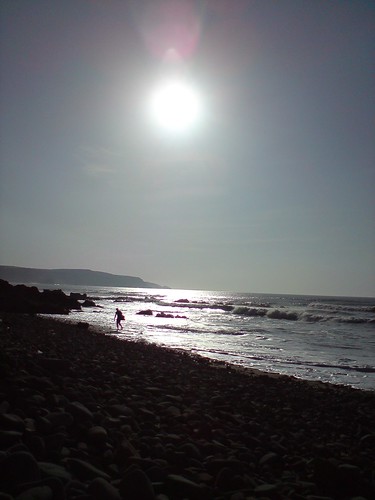Well on old SLR cameras, there used to by the F stop ring. It had values from (i think it was) F3.5 to F22. If you played with this and looked into the lens you could see what it did. You had the lenses. But there was a sheet of metal that had a slot in it. The slot was flared in a curve. If you closed the setting down to F22 it was at the slots thinnest part. Open it up to F3.5 and it was at the widest part. So his was how much light was allowed into the lens. F22 gave front to back sharpness in the photo. F3.5 gave you pinsharp focus on whatever you had focused on. But in front of the focal length so in the fore ground of your subject was blurred right out and the same for behind it.
Take your doggy photo. The grass in the fore ground is blurred right out. The wind has helped but it is wonderfully done. So the dog is in focus. The background is out as well. So the subject, the dog, is what your eye is drawn to.
What makes this picture beautiful is the summer looking colours. And the hazy atmosphere by playing with the F stops. If that had been front to back pinsharp it would have detracted from the dog. It would say "pay attention to everything". But we just gaze past the grasses but have their atmosphere to give context and look at the dog. The light shining through his coat makes it all summer.
Playing with the shutter speed does other things. You can set a longer shutter speed. But this will allow more light (as it has more time to get in) through the lens. If you wanted to take this photo as say, half a second, and you had the F stop open at max for soft focus foreground and background, this would have probably bleached the photo out. To compensate that you close the f stop down. But then it will have more pinsharp focus. You have to decide what you want most and play with the variables.
Slowing the shutter speed though turns a crisp (I can see every drop) waterfall picture, into a beautiful ethereal drape of misty water. Very atmospheric. It lacks drama but hast atmosphere. Speed the shutter up and you get less light in, so you have to compensate by opening the F stop to allow more light in but you have the bluring effect and will not get back to front sharpness. So your manual focusing has to be bang on. Or the whole picture will be pants.
Then to throw more variables in you ave the flash. With your photo you got Cote Jour. Brilliantly. If this had been a person you would have the effect but the face may have been in shadow. So you would use the flash to bring out her face as wll as the cote jour.
If your interested (as I did many years ago), if its still running - amature photographer - ran a correspondence course. You entered and they sent you assignments. You sent them back and they marked your efforts. I have to say as a 12 year old (they didnt know I was that young) posting my film off, then sending the photo to AP, it was so exciting to wait to see if you had passed the assignment. And you got a certificate at the end of the year. I would imagine there are various online versions of it.
With modern point and click boxes, all the same effects can be obtained as a good SLR, you just have to understand about what does what and then trick it.
Just one other rule, colour clashes. Colours that appear opposite in the colour wheel. Our brains love it. So say a person wearing a post box red shirt in a field of OSR, would really get the brain humming. lol. Hope that helps and I know my explanation was probably arse, but there is a world of online experts that can explain it far better than me.
Edit - sorry to go on but there is another valuable light level trick when you have blue skies. The sky will always look bluest in the part of the sky opposite the sun. Have a look. Its a much deeper blue. So if you want a very blue sky in your subject, move round it so that the sky opposite the sun is in the background. Or, if your camera can have attachments get a polarising filter. Of not - like mine - you could use a pair of cheap polarising sunglasses over the lens held in place with a rubber band. Same difference but lower grade optics. But still, you will be amazed how it brings out primary colours in a photo.





